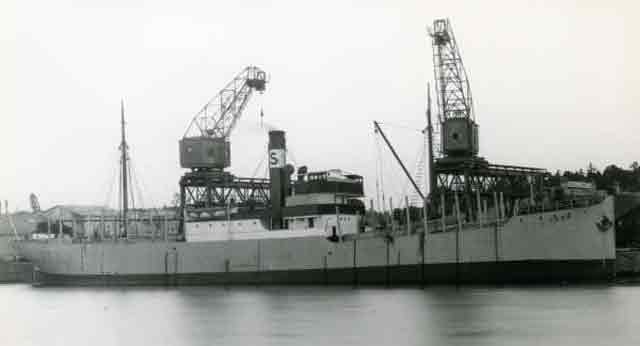Thursday 11 September 1941
 |
| Charles Lindbergh gives a speech for the America First Committee in Des Moines, Iowa, 11 September 1941. |
Do not abandon Kiev and do not blow up the bridges without Stavka permission.The Soviet troops stay put even as the German panzers continue driving toward each other to the east to close an encirclement.
Battle of the Atlantic: On 11 September 1941, Kriegsmarine Wolfpack Markgraf, composed of 14 U-boats in a picket line, confronts Convoy SC-42 in the North Atlantic 100 miles southeast of Greenland. The convoy departed from Nova Scotia on 30 August 1941 bound for Liverpool.
It is a wild affair, with ships sinking all around, some on fire, and men in the water and in lifeboats. The action is confusing and so are the historical records, with different sources identify different ships sunk on different days. However, it is confirmed across all sources that September 10 and September 11, 1941, are horrendous days for Convoy SC-42.
U-82 (Kptlt. Siegfried Rollmann), on its first patrol out of Trondheim, is in the thick of it. It sank 7,465-ton British freighter Empire Hudson on the 10th, and today sinks three ships and seriously damages a fourth in quick succession just after midnight:
- 7519-ton British freighter Bulysses
- 3915-ton British freighter Gypsum Queen
- 1999-ton Swiss freighter Scania (damaged)
- 5463-ton British freighter Empire Crossbill
 |
| Swedish freighter SS Garm, sunk on 11 September 1941 by U-432. There are six deaths from a crew of 20. |
- U-432 (Kptlt. Heinz-Otto Schultze) sinks 1231-ton Swedish freighter Garm
- U-207 (Oberleutnant zur See Fritz Meyer.) sinks British freighters 4924-ton Berury and 4803-ton Stonepool
To add to the devastation, U-105 (Kapitänleutnant Georg Schewe) finds a convoy straggler 1549-ton Panamanian-flagged freighter Montana (a Panamanian flag generally indicates that it is a United States ship).
To date, Convoy SC-42 has lost 15 of its 65 ships. It still has a long way to Liverpool, too. However, as reinforcements, the Admiralty sends naval trawler Buttermere and Flower-class corvettes HMCS Wetaskiwin, HMCS Mimosa, and HMS Gladiolus from convoy HX 147 and the 2nd Escort Group consisting of the Admiralty type flotilla leader HMS Douglas (Commander WE Banks senior officer), the Town-class destroyer HMS Leamington, the V and W-class destroyer HMS Veteran and S-class destroyers HMS Skate and HMS Saladin. This armada guards Convoy SC-42 the rest of the way but SC-42 will lose yet another ship on the way to its destination.
 |
| A barrage balloon station in England garrisoned by the Women’s Auxiliary Air Force (AP Photo). |
These cursed Untermenschen [sub-humans] have been observed eating grass, flowers and raw potatoes. Once they can’t find anything edible in the camp they turn to cannibalism.Hermann Goering hears of this comment and retells it, with some embellishments, often at parties.
Japanese Military: Emperor Hirohito takes personal command of the Japanese Imperial Army. This is merely a ceremonial command, but some analysts in the United States wrongly interpret this as a peaceful gesture.
Admiral Yamamoto and his staff continue planning the attack on Pearl Harbor as he begins ten days of meetings with the Imperial Japanese Navy's General Staff. The Japanese Combined Fleet conducts a training exercise in the North Pacific.
US Military: The ground-breaking ceremonies for the Pentagon building take place in Arlington, Virginia on a patch of farmland. It will take two years to build at a cost of $83 million. The Pentagon is planned to consolidate 17 War Department buildings into one complex. It has been ordered by Brig. General Brehon B. Somervell.
 |
| President Roosevelt with Microphones, September 11, 1941 (NARA). |
We have sought no shooting war with Hitler, we do not seek it now.Roosevelt vows to keep open the seas "no matter what it costs" and likens U-boats to rattlesnakes.
At an American First Committee rally in Des Moines, Iowa, Charles Lindbergh accuses President Roosevelt and his administration of engaging "subterfuge" and using "dictatorial powers" to push his "war party" toward war. His most controversial remark, however, follows:
The three most important groups who have been pressing this country toward war are the British, the Jewish and the Roosevelt administration.This remark and others during the speech are similar to the public statements of Adolf Hitler.
 |
| Vizeadmiral Johannes Bachmann (KIA April 1945) inspects Schiermonnikoog 'Vredenhof' Cemetery in the Dutch Frisian Islands, 11 September 1941. |
September 1941
September 1, 1941: Two Years In
September 2, 1941: Germans Pushed Back at Yelnya
September 3, 1941: FDR Refuses to Meet with Japanese
September 4, 1941: Hitler Furious at Guderian
September 5, 1941: Germans Evacuate Yelnya
September 6, 1941: Japan Prepares for War
September 7, 1941: Hitler Orders Drive on Moscow
September 8, 1941: Leningrad Cut Off
September 9, 1941: Germans Attack Leningrad
September 10, 1941: Guderian Busts Loose
September 11, 1941: Convoy SC-42 Destruction
September 12, 1941: Starve Leningrad!
September 13, 1941: Zhukov at Leningrad
September 14, 1941: Germany's Growing Casualties
September 15, 1941: Sorge Warns Stalin Again
September 16, 1941: Soviets Encircled at Kiev
September 17, 1941: Iran Conquest Completed
September 18, 1941: Focke-Wulf Fw 190 in Action
September 19, 1941: Germans Take Kiev
September 20, 1941: Death at Kiev
September 21, 1941: Raging Soviet Paranoia
September 22, 1941: Defense of Nickel Mines
September 23, 1941: Air Attacks on Leningrad
September 24, 1941: Japanese Spying Intensifies
September 25, 1941: Manstein at the Crimea
September 26, 1941: Kiev Pocket Eliminated
September 27, 1941: Massacre at Eišiškės
September 28, 1941: Ted Williams Hits .400
September 29, 1941: Babi Yar Massacre
September 30, 1941: Operation Typhoon Begins
2020
No comments:
Post a Comment